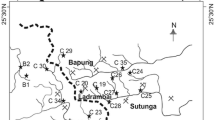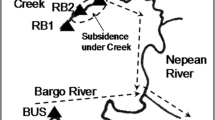Abstract
Chemical characteristics of the stream water and sediment in the small watershed with two distinctive mineralization zones (Cu and Pb−Zn), 7 abandoned mines and an active quarry were investigated to examine the effects of mining activity and regional geology on the chemistry. The stream water affected by the abandoned mines had Ca−SO4 type but the other had Ca−HCO3 type. The mine affected stream water and sediment showed relatively high concentrations of metals (Cu, Pb, Zn, Cd, Co, Ni, Mn, Al and Fe). The concentrations of Al, Mn, Fe and Cu of the stream water collected near an abandoned mine (Guryong) exceeded the EPA surface water quality standards (Al: 5.52 mg L−1, Mn: 1.58 mg L−1, Fe: 1.49 mg L−1, Cu: 0.63 mg L−1). The effect of mining activity on the stream water chemistry was attenuated in a relatively short distance from the source (<200 m) along the watercourse but the signature in the sediment showed a longer lasting effect (about 2 km) than that in the stream water: The residual and reducible forms were the dominant fractions of the heavy metals in the stream sediment. The particulate trnnsportation was the major cause of the dispersion of heavy metals in the watershed. There was a contrasting spatial distribution of background metal concentration in the stream sediment: a relatively higher concentration of Cu in the Cu mineralization zone and a relatively higher concentration of Pb, Zn and Mn in the Pb−Zn mineralization zone.
Similar content being viewed by others
References
Ahn J.S., Kim J.H., Kim J.G., Song Y. and Moon H.S., 2003, Laboratory investigation of the behavior of metals in paddy soils contaminated with mine tailings. Water, Air, and Soil Pollution, 150, 23–42.
Fukushima K., Nakajima R., Sato A. and Sakurai T., 2000, Relationships between stream water chemistry and catchment geology in a mountaineous region in Nagano Perfecture, Japan II: mid to southern part along the Median Tectonic Line. Limnology, 1, 117–127.
Garcia-Sanchez A. and Alvarez-Ayuso, E., 2003, Arsenic in soils and waters and its relation to geology and mining activities (Salamance Province, Spain). Journal of Geochemical Exploration, 89, 69–79.
Gurrieri, J.T., 1998, Distribution of metals in water and sediment and effects on aquatic biota in the upper Still water River basin, Montana. Journal of Geochemical Exploration, 64, 83–100.
Helgen S.O. and Davis A., 2000, Quantifying metal contribution from multiple sources to the Clark Fprk River, Montana, U.S.A. Journal of Environmental Forensics, 1, 55–62.
Helgen S.O. and Moore J.N., 1996 Natural background determination and impact quantification in trace metal-contaminated river sediments. Environmental Science and Technology, 30, 129–135.
Holloway J.M. and Dahlgren R.A., 2001, Seasonal and event-scale variations in solute chemistry for four Sierra Nevada catchments. Journal of Hydrology, 250, 106–121.
Leblanc M., Morales J.A., Borrego J. and Elbaz-Poulichet F. 2000, 4,500 year old mining pollution in southwestern Spain: Long term implications for modern mining pollution. Economic Geology and The Bulletin of The Society of Economic Geologists, 95, 655–662.
Meglen R.R., 1992, Examination of large database: a chemometeric approach using principal component analysis. Marine Chemistry, 39, 217–237.
Ohta A., Imai N., Terashima S. and Tachibana Y., 2005, Application of multi-element statistical analysis for regional geochemical mapping in Central Japan. Applied Geochemistry, 20, 1017–1037.
Pinol J., Avila A. and Roda F., 1992, The seasonal variation of stream water chemistry in three forested Mediterranean catchments. Journal of Hydrology, 140, 119–141.
Pirrie D., Power M.R., Wheeler P.D., Cundy A., Bridges C. and Davey G., 2002, Geochmical signature of historical mining: Fowey Estuary, Cornwall, UK. Journal of Geochemical Exploration, 76, 31–43.
Pirrie D., Camm G. S., Sear L.G. and Hughes S.H., 1997, Mineralogical and geochemical signature of mine waste contamination, Tresillian River, Fal Estuary, Cornwall, UK. Environmental Geology, 29, 58–65.
Prusty B.G., Sahu K.C. and Godgul G. 1994, Metal contamination due to mining and milling activities at the Zawar zinc mine, Rajasthan, India. Chemical Geology, 112, 275–291.
Wenchuan Q. and Kelderman P., 2001, Heavy metal contents in the Delft canal sediments and suspended solids of the River Rhine: Multivariate analysis for source tracing. Chemosphere, 45, 919–925.
Wilson B., Lang B. and Pyatt F.B., 2005, The dispersion of heavy metals in the vicinity of Britannia mine, British Columbia, Canada. Ecotoxicology and Environmental Safety, 60, 269–276.
Author information
Authors and Affiliations
Corresponding author
Rights and permissions
About this article
Cite this article
Kim, J.G., Ko, KS., Kim, T.H. et al. Effect of mining and geology on the chemistry of stream water and sediment in a small watershed. Geosci J 11, 175–183 (2007). https://doi.org/10.1007/BF02913931
Received:
Accepted:
Issue Date:
DOI: https://doi.org/10.1007/BF02913931




